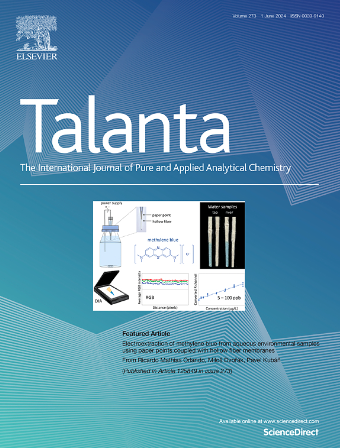基于质子转移的AIE荧光探针用于Sn2+的比例和选择性检测。
IF 6.1
1区 化学
Q1 CHEMISTRY, ANALYTICAL
引用次数: 0
摘要
检测Sn2+重金属离子对减轻水污染、保障人体健康至关重要。本研究设计并合成了一种新型荧光探针RTPE-IM,该探针是聚集诱导发光团(TPE)和罗丹明b的组合,探针在Sn2+离子存在下进行质子转移,具有高选择性和低检测限0.121 μM。该分子的合成和应用为预防环境健康风险提供了一种潜在的策略。本文章由计算机程序翻译,如有差异,请以英文原文为准。
An AIE fluorescence probe for ratiometric and selective detection of Sn2+ based on proton transfer.
Detecting Sn2+ heavy metal ions is crucial for mitigating water pollution and safeguarding human health. This study involved the design and synthesis of a novel fluorescence probe, RTPE-IM, which is a combination of an aggregation-induced emission luminophore (TPE) and rhodamine B. The probe undergoes proton transfer in the presence of Sn2+ ion, displaying high selectivity and a low detection limit of 0.121 μM. The synthesis and application of this molecule offer a potential strategy for preventing environmental health risks.
求助全文
通过发布文献求助,成功后即可免费获取论文全文。
去求助
来源期刊

Talanta
化学-分析化学
CiteScore
12.30
自引率
4.90%
发文量
861
审稿时长
29 days
期刊介绍:
Talanta provides a forum for the publication of original research papers, short communications, and critical reviews in all branches of pure and applied analytical chemistry. Papers are evaluated based on established guidelines, including the fundamental nature of the study, scientific novelty, substantial improvement or advantage over existing technology or methods, and demonstrated analytical applicability. Original research papers on fundamental studies, and on novel sensor and instrumentation developments, are encouraged. Novel or improved applications in areas such as clinical and biological chemistry, environmental analysis, geochemistry, materials science and engineering, and analytical platforms for omics development are welcome.
Analytical performance of methods should be determined, including interference and matrix effects, and methods should be validated by comparison with a standard method, or analysis of a certified reference material. Simple spiking recoveries may not be sufficient. The developed method should especially comprise information on selectivity, sensitivity, detection limits, accuracy, and reliability. However, applying official validation or robustness studies to a routine method or technique does not necessarily constitute novelty. Proper statistical treatment of the data should be provided. Relevant literature should be cited, including related publications by the authors, and authors should discuss how their proposed methodology compares with previously reported methods.
 求助内容:
求助内容: 应助结果提醒方式:
应助结果提醒方式:


